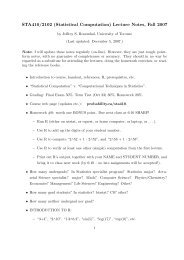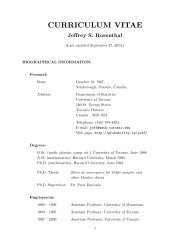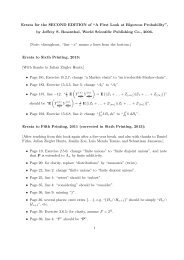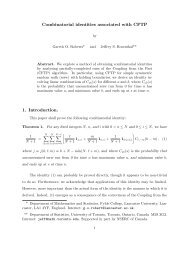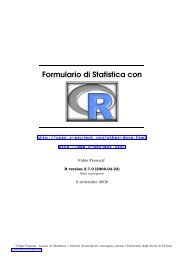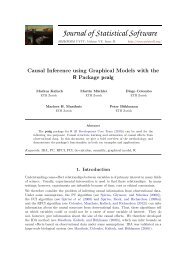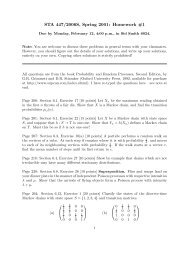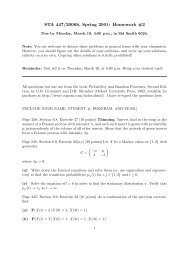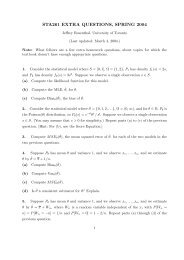final report - probability.ca
final report - probability.ca
final report - probability.ca
Create successful ePaper yourself
Turn your PDF publications into a flip-book with our unique Google optimized e-Paper software.
2.5 Optimal S<strong>ca</strong>ling of RWM with Discontinuous Target Densities<br />
2.5.1 Inefficiencies of full-dimensional updates using RWM applied to discontinuous targets<br />
All the results proven thus far have been for continuous target densities. In [NRY05], the authors provide a weak<br />
convergence result for a high-dimensional RWM algorithm applied to a target distribution which has a discontinuous<br />
<strong>probability</strong> density function. In particular, they show that when the proposal variance is s<strong>ca</strong>led by d −2 , the sequence<br />
of stochastic processes formed by the first component of each Markov chain converges to a Langevin diffusion process<br />
whose speed measure is optimized when the algorithm is tuned to yield an acceptance rate of e −2 ≈ 0.1353. Hence,<br />
the mixing time for the RWM algorithm when applied to discontinuous densities is O ( d 2) . This work serves as a<br />
validation of the result of [NR05], where it was found that lower dimensional updates are more efficient in the RWM<br />
setting due to the lower computational cost. In fact, [NR05] showed that the Metropolis-within-Gibbs algorithms<br />
mix with rate O (d), which compares favorably to the mixing rate of O ( d 2) required in the current context for<br />
RWM algorithms applied to discontinuous target densities.<br />
The target density in consideration is given by<br />
where<br />
( )<br />
π x (d) , d =<br />
d∏<br />
f (x i ) ,<br />
i=1<br />
f (x) ∝ exp (g (x)) ,<br />
with 0 < x < 1, g (·) twice differentiable on [0, 1], and f (x) = 0 otherwise.<br />
2.5.2 Algorithm and Main Results<br />
For d ≥ 1, consider a RWM algorithm on the d-dimensional hypercube with target density π ( x (d) , d ) as given<br />
above. As always, suppose the algorithm starts in stationarity, so X (d)<br />
0 ∼ π (·), and for t ≥ 0 and i ≥ 1, denote by<br />
Z t,i elements of a sequence of i.i.d. uniform random variables with Z ∼ U [−1, 1] , with Z (d)<br />
t = (Z t,1 , Z t,2 , . . . , Z t,d ).<br />
For d ≥ 1, t ≥ 0 and l > 0, consider the proposals given by<br />
Y (d)<br />
t+1 = X(d) t + σ (d) Z (d)<br />
t ,<br />
(Y<br />
(1, π (d)<br />
where σ (d) = l/d. Accept these proposals with <strong>probability</strong> min<br />
(<br />
π<br />
)<br />
t+1<br />
)<br />
X (d)<br />
t<br />
{<br />
( )<br />
h z (d) 2 −d , z (d) ∈ (−1, 1) d<br />
, d =<br />
0, otherwise.<br />
)<br />
. Thus, for d ≥ 1, let<br />
Given the current state of the process x (d) , denote by J ( x (d) , d ) the <strong>probability</strong> of accepting a proposal,<br />
J<br />
( ) ˆ<br />
x (d) , d =<br />
(<br />
h z (d) , d) { min<br />
(1, π ( x (d) + σ ( z (d) , d )) )}<br />
π ( x (d)) dz (d) .<br />
It is now necessary to define a pseudo-RWM process, which is identi<strong>ca</strong>l to the regular RWM process except that it<br />
(d) (d)<br />
moves at every iteration. For d ≥ 1, let ˆX 0 , ˆX 1 , . . . denote the successive states of the pseudo-RWM process,<br />
with<br />
ˆX<br />
(d)<br />
given that<br />
0 ∼ π (·). The pseudo-RWM process is a Markov process, where for t ≥ 0<br />
ˆX<br />
(d)<br />
t<br />
with z (d) ∈ R d .<br />
= x (d) , the pdf of Ẑ(d) t<br />
is given by<br />
(<br />
ζ z (d) |x (d)) ( )<br />
= h z (d) , d min<br />
{1, π ( x (d) + σ (d) z (d))<br />
} /<br />
π ( x (d)) J<br />
ˆX<br />
(d)<br />
t+1 =<br />
( )<br />
x (d) , d ,<br />
ˆX<br />
(d)<br />
t<br />
+ σ (d) Ẑ(d) t , and<br />
26



